International HRM Reflective Learning Report: Concepts and Critique
VerifiedAdded on 2023/01/18
|19
|5309
|76
Report
AI Summary
This reflective learning report delves into the multifaceted realm of International Human Resource Management (IHRM). It begins by contrasting IHRM with domestic HRM, highlighting the increased complexities and challenges of operating in a global market. The report then critically compares key IHRM concepts and theories, including the definition, purpose, and objectives of IHRM, along with its practices and policies, such as talent management, international assignment management, and workforce diversity. It explores the IHRM model, encompassing HR activities, types of employees (PCN, HCN, TCN), and country classifications (home, host, other). The report also examines the influence of environmental and cultural differences, including the Hofstede cultural dimensions model, and the concepts of convergence and divergence in HRM. Furthermore, it critiques the use of HRM in an international context, addressing challenges, commitment, and cost-effectiveness, with a focus on expatriate management. The report provides a comprehensive overview of the critical aspects of IHRM, offering valuable insights into managing human resources in a globalized business environment.
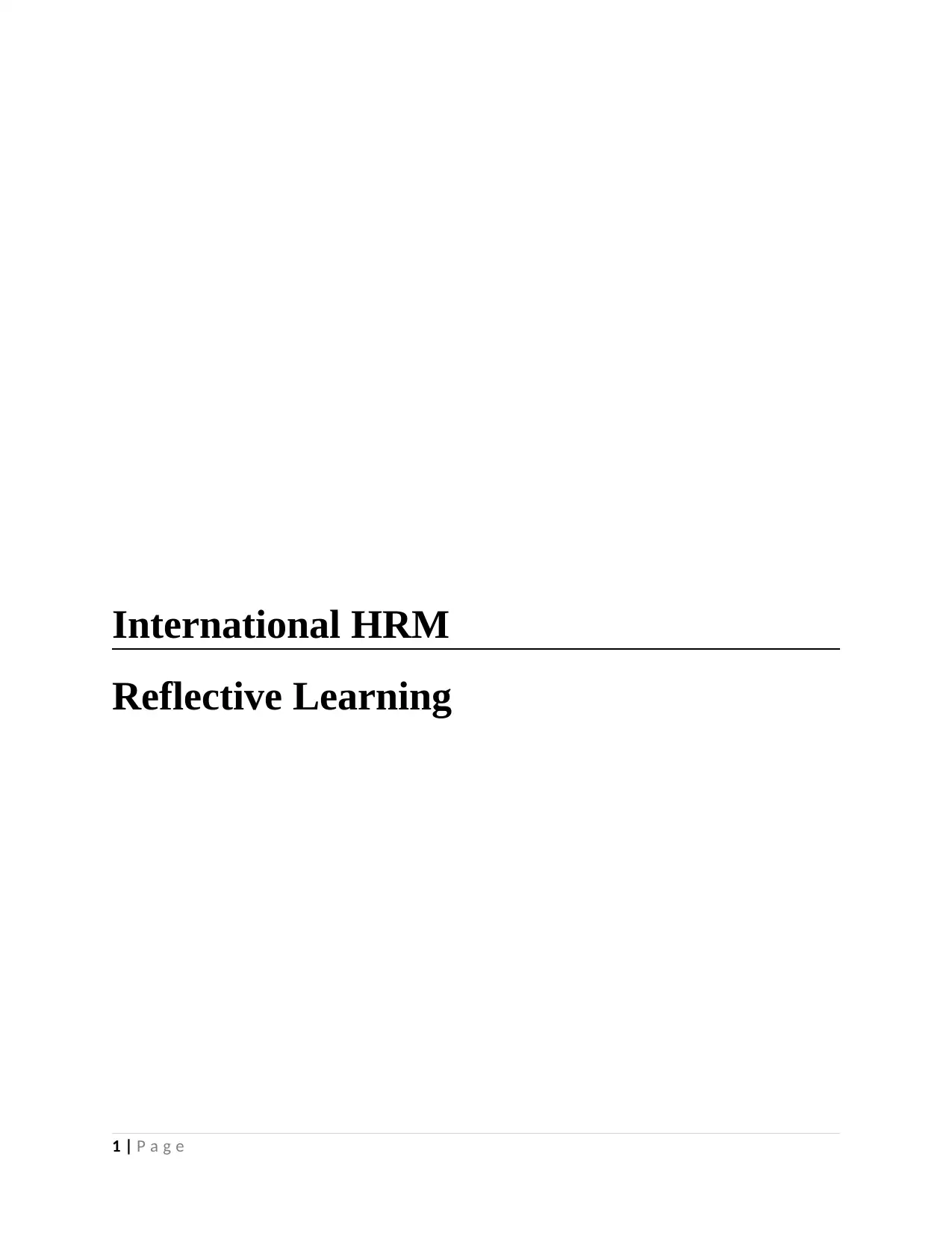
International HRM
Reflective Learning
1 | P a g e
Reflective Learning
1 | P a g e
Paraphrase This Document
Need a fresh take? Get an instant paraphrase of this document with our AI Paraphraser
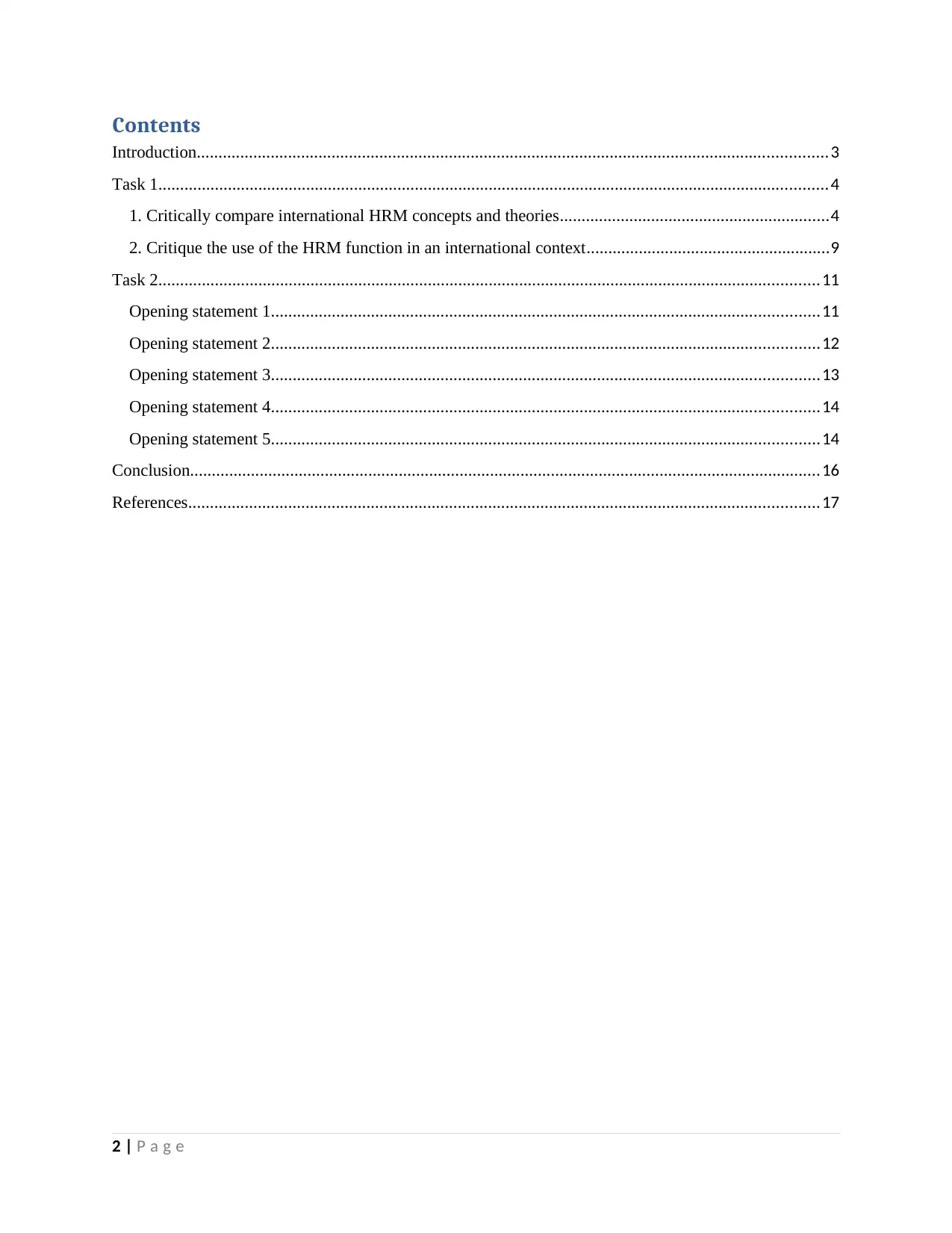
Contents
Introduction.................................................................................................................................................3
Task 1..........................................................................................................................................................4
1. Critically compare international HRM concepts and theories..............................................................4
2. Critique the use of the HRM function in an international context........................................................9
Task 2........................................................................................................................................................11
Opening statement 1..............................................................................................................................11
Opening statement 2..............................................................................................................................12
Opening statement 3..............................................................................................................................13
Opening statement 4..............................................................................................................................14
Opening statement 5..............................................................................................................................14
Conclusion.................................................................................................................................................16
References.................................................................................................................................................17
2 | P a g e
Introduction.................................................................................................................................................3
Task 1..........................................................................................................................................................4
1. Critically compare international HRM concepts and theories..............................................................4
2. Critique the use of the HRM function in an international context........................................................9
Task 2........................................................................................................................................................11
Opening statement 1..............................................................................................................................11
Opening statement 2..............................................................................................................................12
Opening statement 3..............................................................................................................................13
Opening statement 4..............................................................................................................................14
Opening statement 5..............................................................................................................................14
Conclusion.................................................................................................................................................16
References.................................................................................................................................................17
2 | P a g e
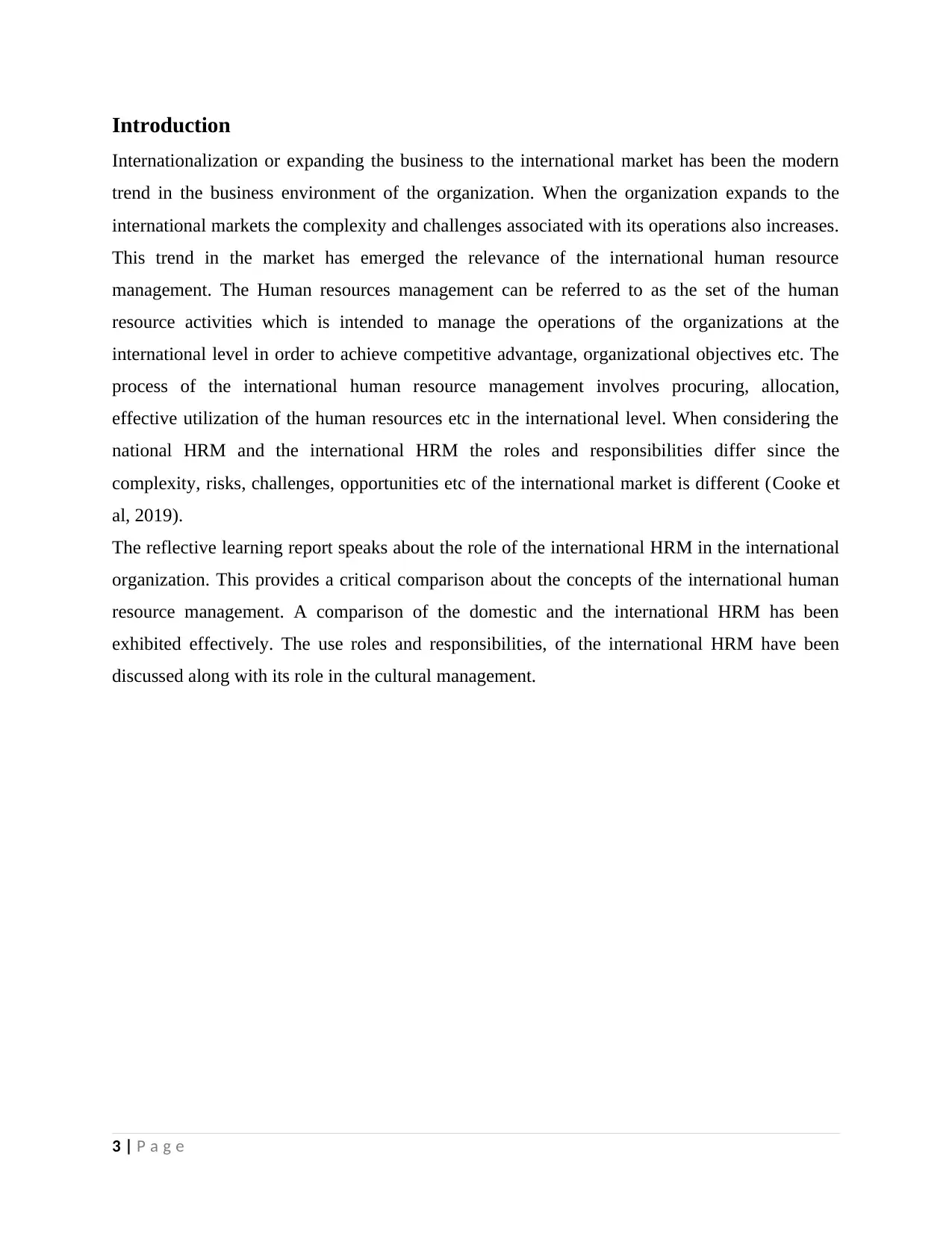
Introduction
Internationalization or expanding the business to the international market has been the modern
trend in the business environment of the organization. When the organization expands to the
international markets the complexity and challenges associated with its operations also increases.
This trend in the market has emerged the relevance of the international human resource
management. The Human resources management can be referred to as the set of the human
resource activities which is intended to manage the operations of the organizations at the
international level in order to achieve competitive advantage, organizational objectives etc. The
process of the international human resource management involves procuring, allocation,
effective utilization of the human resources etc in the international level. When considering the
national HRM and the international HRM the roles and responsibilities differ since the
complexity, risks, challenges, opportunities etc of the international market is different (Cooke et
al, 2019).
The reflective learning report speaks about the role of the international HRM in the international
organization. This provides a critical comparison about the concepts of the international human
resource management. A comparison of the domestic and the international HRM has been
exhibited effectively. The use roles and responsibilities, of the international HRM have been
discussed along with its role in the cultural management.
3 | P a g e
Internationalization or expanding the business to the international market has been the modern
trend in the business environment of the organization. When the organization expands to the
international markets the complexity and challenges associated with its operations also increases.
This trend in the market has emerged the relevance of the international human resource
management. The Human resources management can be referred to as the set of the human
resource activities which is intended to manage the operations of the organizations at the
international level in order to achieve competitive advantage, organizational objectives etc. The
process of the international human resource management involves procuring, allocation,
effective utilization of the human resources etc in the international level. When considering the
national HRM and the international HRM the roles and responsibilities differ since the
complexity, risks, challenges, opportunities etc of the international market is different (Cooke et
al, 2019).
The reflective learning report speaks about the role of the international HRM in the international
organization. This provides a critical comparison about the concepts of the international human
resource management. A comparison of the domestic and the international HRM has been
exhibited effectively. The use roles and responsibilities, of the international HRM have been
discussed along with its role in the cultural management.
3 | P a g e
⊘ This is a preview!⊘
Do you want full access?
Subscribe today to unlock all pages.

Trusted by 1+ million students worldwide
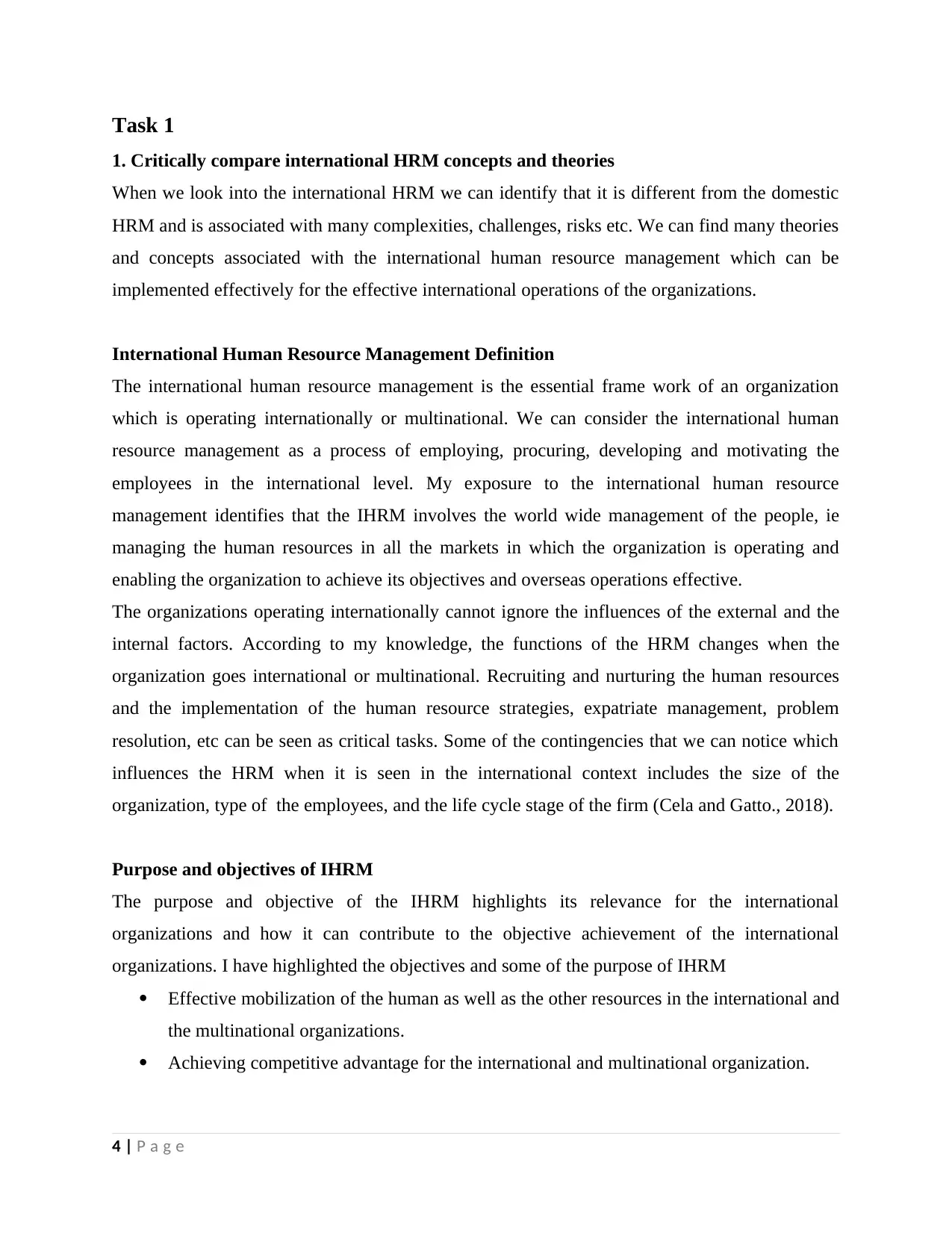
Task 1
1. Critically compare international HRM concepts and theories
When we look into the international HRM we can identify that it is different from the domestic
HRM and is associated with many complexities, challenges, risks etc. We can find many theories
and concepts associated with the international human resource management which can be
implemented effectively for the effective international operations of the organizations.
International Human Resource Management Definition
The international human resource management is the essential frame work of an organization
which is operating internationally or multinational. We can consider the international human
resource management as a process of employing, procuring, developing and motivating the
employees in the international level. My exposure to the international human resource
management identifies that the IHRM involves the world wide management of the people, ie
managing the human resources in all the markets in which the organization is operating and
enabling the organization to achieve its objectives and overseas operations effective.
The organizations operating internationally cannot ignore the influences of the external and the
internal factors. According to my knowledge, the functions of the HRM changes when the
organization goes international or multinational. Recruiting and nurturing the human resources
and the implementation of the human resource strategies, expatriate management, problem
resolution, etc can be seen as critical tasks. Some of the contingencies that we can notice which
influences the HRM when it is seen in the international context includes the size of the
organization, type of the employees, and the life cycle stage of the firm (Cela and Gatto., 2018).
Purpose and objectives of IHRM
The purpose and objective of the IHRM highlights its relevance for the international
organizations and how it can contribute to the objective achievement of the international
organizations. I have highlighted the objectives and some of the purpose of IHRM
Effective mobilization of the human as well as the other resources in the international and
the multinational organizations.
Achieving competitive advantage for the international and multinational organization.
4 | P a g e
1. Critically compare international HRM concepts and theories
When we look into the international HRM we can identify that it is different from the domestic
HRM and is associated with many complexities, challenges, risks etc. We can find many theories
and concepts associated with the international human resource management which can be
implemented effectively for the effective international operations of the organizations.
International Human Resource Management Definition
The international human resource management is the essential frame work of an organization
which is operating internationally or multinational. We can consider the international human
resource management as a process of employing, procuring, developing and motivating the
employees in the international level. My exposure to the international human resource
management identifies that the IHRM involves the world wide management of the people, ie
managing the human resources in all the markets in which the organization is operating and
enabling the organization to achieve its objectives and overseas operations effective.
The organizations operating internationally cannot ignore the influences of the external and the
internal factors. According to my knowledge, the functions of the HRM changes when the
organization goes international or multinational. Recruiting and nurturing the human resources
and the implementation of the human resource strategies, expatriate management, problem
resolution, etc can be seen as critical tasks. Some of the contingencies that we can notice which
influences the HRM when it is seen in the international context includes the size of the
organization, type of the employees, and the life cycle stage of the firm (Cela and Gatto., 2018).
Purpose and objectives of IHRM
The purpose and objective of the IHRM highlights its relevance for the international
organizations and how it can contribute to the objective achievement of the international
organizations. I have highlighted the objectives and some of the purpose of IHRM
Effective mobilization of the human as well as the other resources in the international and
the multinational organizations.
Achieving competitive advantage for the international and multinational organization.
4 | P a g e
Paraphrase This Document
Need a fresh take? Get an instant paraphrase of this document with our AI Paraphraser
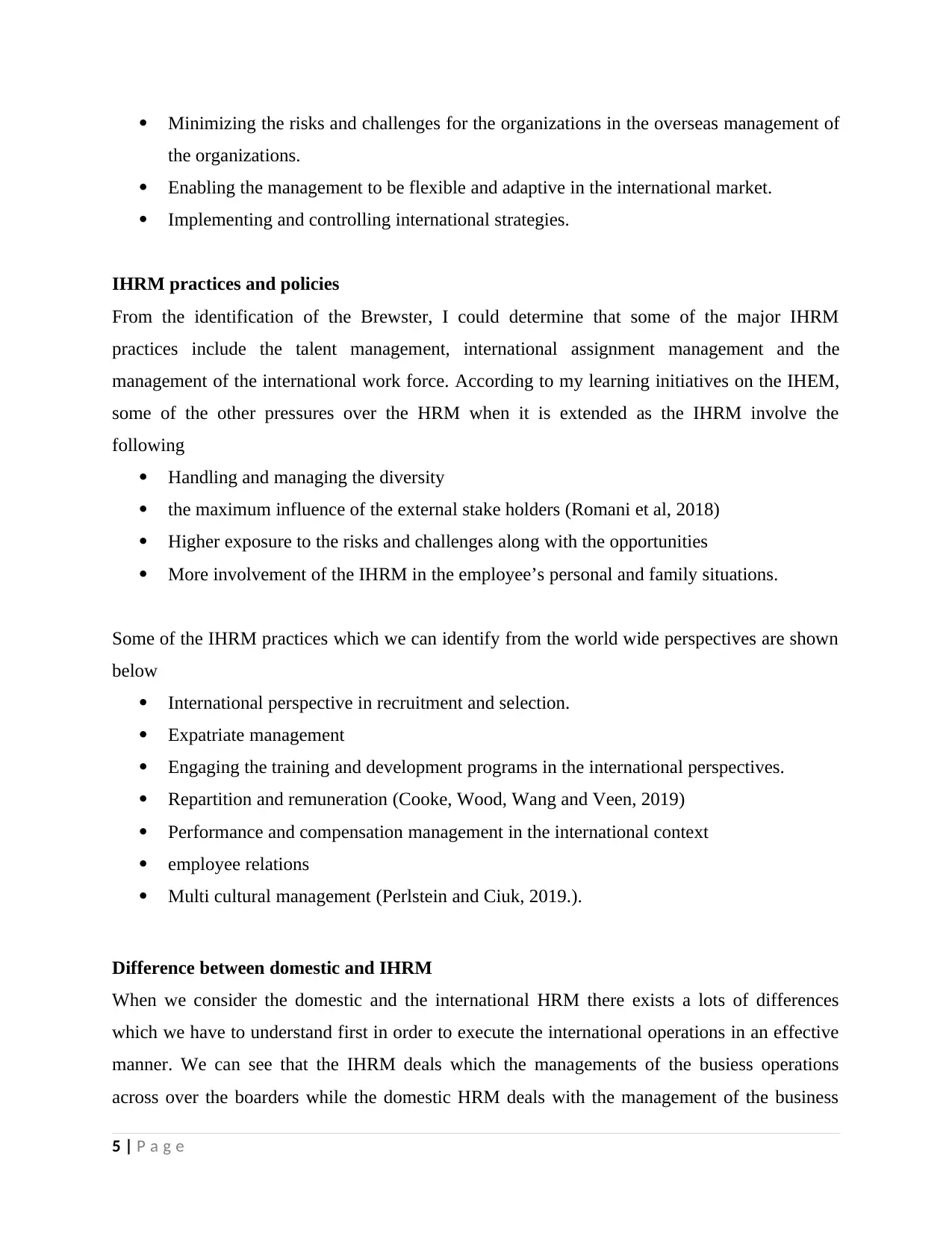
Minimizing the risks and challenges for the organizations in the overseas management of
the organizations.
Enabling the management to be flexible and adaptive in the international market.
Implementing and controlling international strategies.
IHRM practices and policies
From the identification of the Brewster, I could determine that some of the major IHRM
practices include the talent management, international assignment management and the
management of the international work force. According to my learning initiatives on the IHEM,
some of the other pressures over the HRM when it is extended as the IHRM involve the
following
Handling and managing the diversity
the maximum influence of the external stake holders (Romani et al, 2018)
Higher exposure to the risks and challenges along with the opportunities
More involvement of the IHRM in the employee’s personal and family situations.
Some of the IHRM practices which we can identify from the world wide perspectives are shown
below
International perspective in recruitment and selection.
Expatriate management
Engaging the training and development programs in the international perspectives.
Repartition and remuneration (Cooke, Wood, Wang and Veen, 2019)
Performance and compensation management in the international context
employee relations
Multi cultural management (Perlstein and Ciuk, 2019.).
Difference between domestic and IHRM
When we consider the domestic and the international HRM there exists a lots of differences
which we have to understand first in order to execute the international operations in an effective
manner. We can see that the IHRM deals which the managements of the busiess operations
across over the boarders while the domestic HRM deals with the management of the business
5 | P a g e
the organizations.
Enabling the management to be flexible and adaptive in the international market.
Implementing and controlling international strategies.
IHRM practices and policies
From the identification of the Brewster, I could determine that some of the major IHRM
practices include the talent management, international assignment management and the
management of the international work force. According to my learning initiatives on the IHEM,
some of the other pressures over the HRM when it is extended as the IHRM involve the
following
Handling and managing the diversity
the maximum influence of the external stake holders (Romani et al, 2018)
Higher exposure to the risks and challenges along with the opportunities
More involvement of the IHRM in the employee’s personal and family situations.
Some of the IHRM practices which we can identify from the world wide perspectives are shown
below
International perspective in recruitment and selection.
Expatriate management
Engaging the training and development programs in the international perspectives.
Repartition and remuneration (Cooke, Wood, Wang and Veen, 2019)
Performance and compensation management in the international context
employee relations
Multi cultural management (Perlstein and Ciuk, 2019.).
Difference between domestic and IHRM
When we consider the domestic and the international HRM there exists a lots of differences
which we have to understand first in order to execute the international operations in an effective
manner. We can see that the IHRM deals which the managements of the busiess operations
across over the boarders while the domestic HRM deals with the management of the business
5 | P a g e
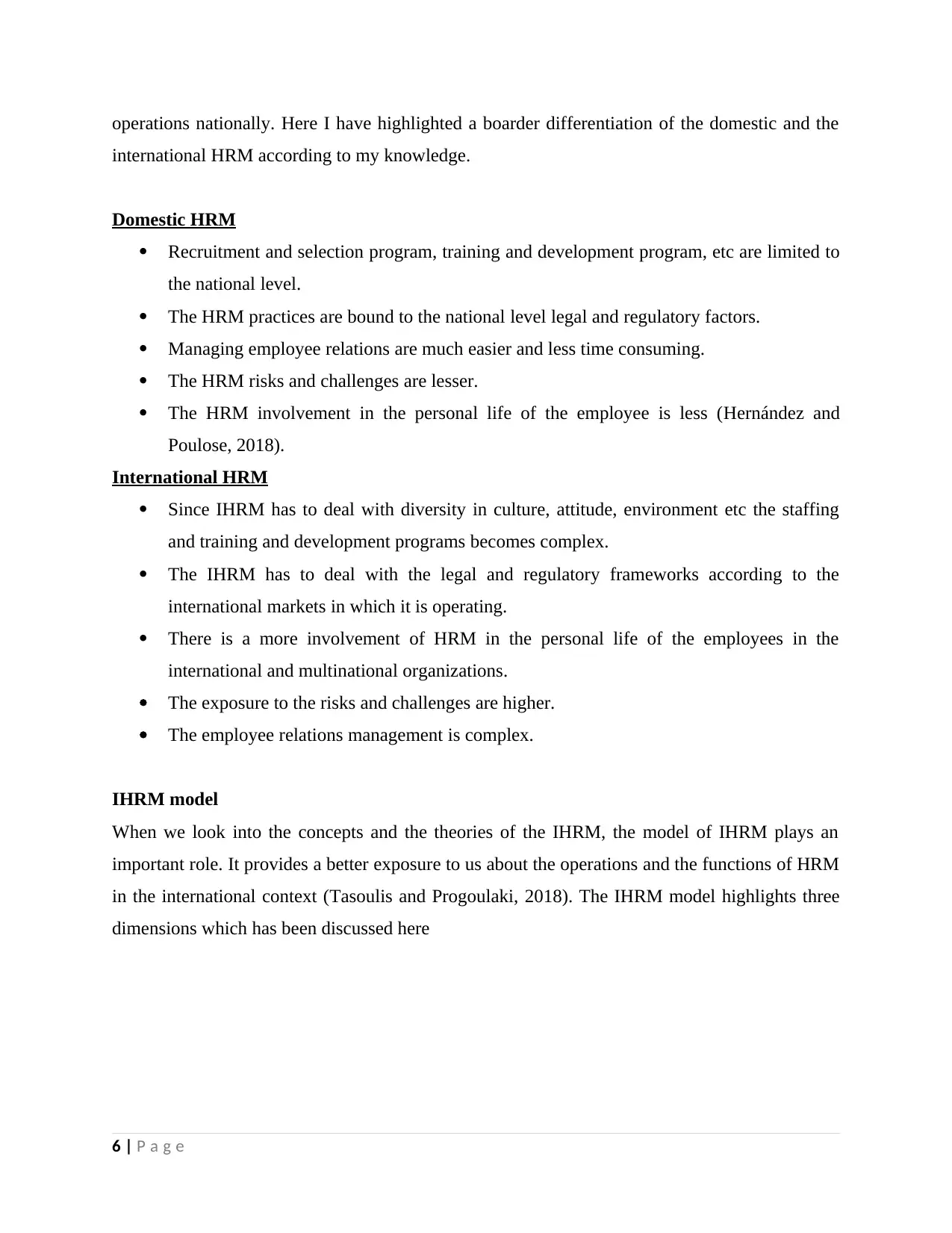
operations nationally. Here I have highlighted a boarder differentiation of the domestic and the
international HRM according to my knowledge.
Domestic HRM
Recruitment and selection program, training and development program, etc are limited to
the national level.
The HRM practices are bound to the national level legal and regulatory factors.
Managing employee relations are much easier and less time consuming.
The HRM risks and challenges are lesser.
The HRM involvement in the personal life of the employee is less (Hernández and
Poulose, 2018).
International HRM
Since IHRM has to deal with diversity in culture, attitude, environment etc the staffing
and training and development programs becomes complex.
The IHRM has to deal with the legal and regulatory frameworks according to the
international markets in which it is operating.
There is a more involvement of HRM in the personal life of the employees in the
international and multinational organizations.
The exposure to the risks and challenges are higher.
The employee relations management is complex.
IHRM model
When we look into the concepts and the theories of the IHRM, the model of IHRM plays an
important role. It provides a better exposure to us about the operations and the functions of HRM
in the international context (Tasoulis and Progoulaki, 2018). The IHRM model highlights three
dimensions which has been discussed here
6 | P a g e
international HRM according to my knowledge.
Domestic HRM
Recruitment and selection program, training and development program, etc are limited to
the national level.
The HRM practices are bound to the national level legal and regulatory factors.
Managing employee relations are much easier and less time consuming.
The HRM risks and challenges are lesser.
The HRM involvement in the personal life of the employee is less (Hernández and
Poulose, 2018).
International HRM
Since IHRM has to deal with diversity in culture, attitude, environment etc the staffing
and training and development programs becomes complex.
The IHRM has to deal with the legal and regulatory frameworks according to the
international markets in which it is operating.
There is a more involvement of HRM in the personal life of the employees in the
international and multinational organizations.
The exposure to the risks and challenges are higher.
The employee relations management is complex.
IHRM model
When we look into the concepts and the theories of the IHRM, the model of IHRM plays an
important role. It provides a better exposure to us about the operations and the functions of HRM
in the international context (Tasoulis and Progoulaki, 2018). The IHRM model highlights three
dimensions which has been discussed here
6 | P a g e
⊘ This is a preview!⊘
Do you want full access?
Subscribe today to unlock all pages.

Trusted by 1+ million students worldwide
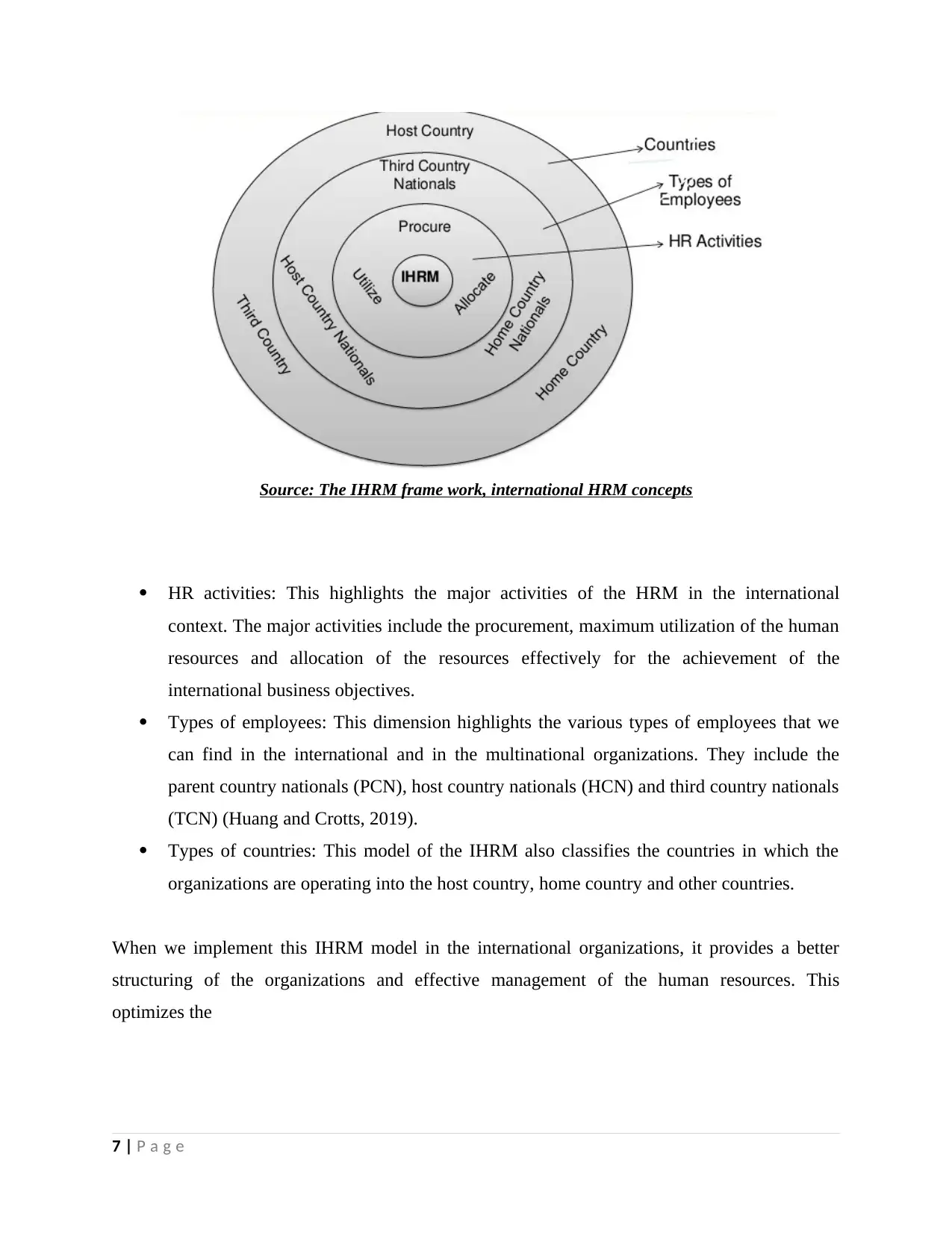
Source: The IHRM frame work, international HRM concepts
HR activities: This highlights the major activities of the HRM in the international
context. The major activities include the procurement, maximum utilization of the human
resources and allocation of the resources effectively for the achievement of the
international business objectives.
Types of employees: This dimension highlights the various types of employees that we
can find in the international and in the multinational organizations. They include the
parent country nationals (PCN), host country nationals (HCN) and third country nationals
(TCN) (Huang and Crotts, 2019).
Types of countries: This model of the IHRM also classifies the countries in which the
organizations are operating into the host country, home country and other countries.
When we implement this IHRM model in the international organizations, it provides a better
structuring of the organizations and effective management of the human resources. This
optimizes the
7 | P a g e
HR activities: This highlights the major activities of the HRM in the international
context. The major activities include the procurement, maximum utilization of the human
resources and allocation of the resources effectively for the achievement of the
international business objectives.
Types of employees: This dimension highlights the various types of employees that we
can find in the international and in the multinational organizations. They include the
parent country nationals (PCN), host country nationals (HCN) and third country nationals
(TCN) (Huang and Crotts, 2019).
Types of countries: This model of the IHRM also classifies the countries in which the
organizations are operating into the host country, home country and other countries.
When we implement this IHRM model in the international organizations, it provides a better
structuring of the organizations and effective management of the human resources. This
optimizes the
7 | P a g e
Paraphrase This Document
Need a fresh take? Get an instant paraphrase of this document with our AI Paraphraser
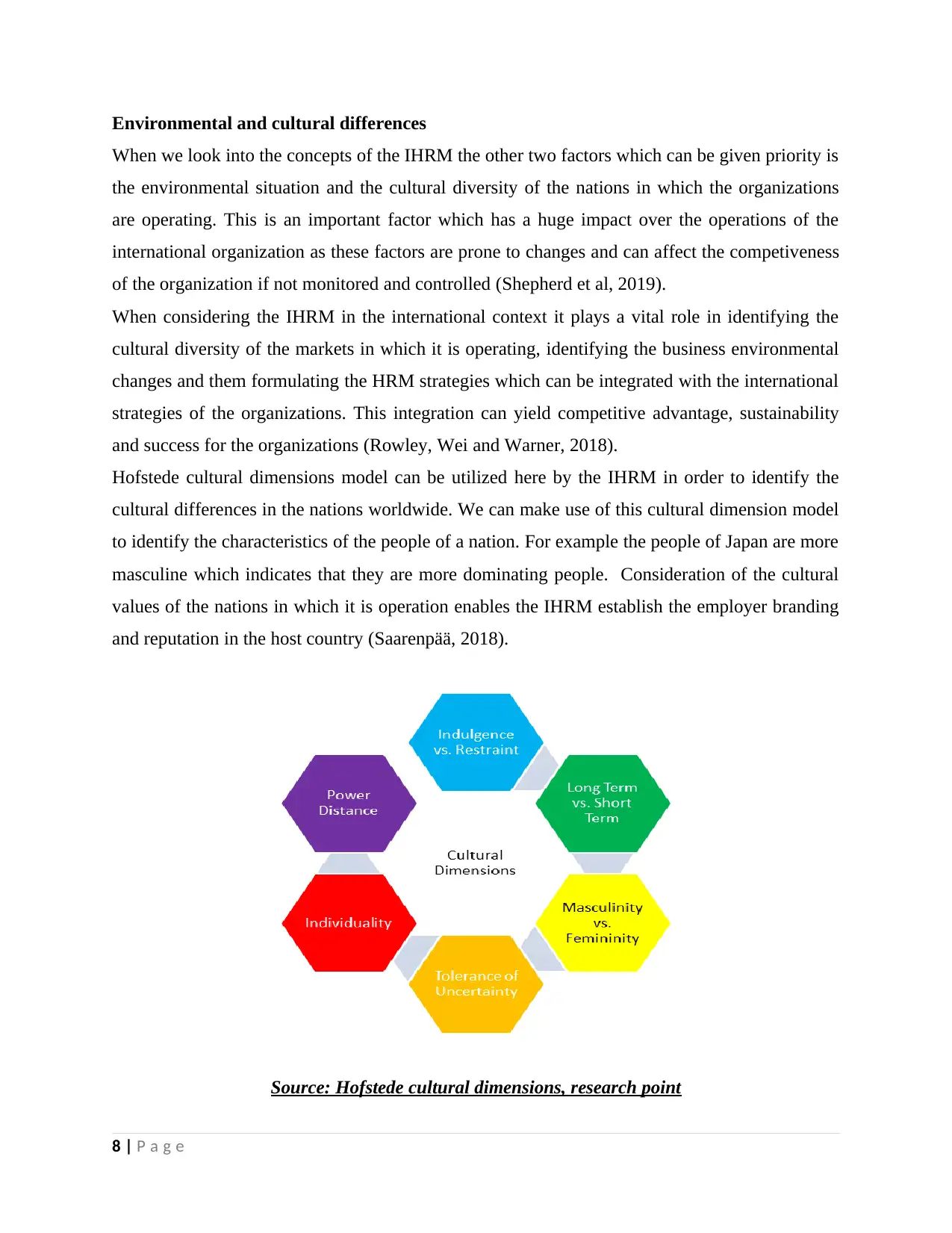
Environmental and cultural differences
When we look into the concepts of the IHRM the other two factors which can be given priority is
the environmental situation and the cultural diversity of the nations in which the organizations
are operating. This is an important factor which has a huge impact over the operations of the
international organization as these factors are prone to changes and can affect the competiveness
of the organization if not monitored and controlled (Shepherd et al, 2019).
When considering the IHRM in the international context it plays a vital role in identifying the
cultural diversity of the markets in which it is operating, identifying the business environmental
changes and them formulating the HRM strategies which can be integrated with the international
strategies of the organizations. This integration can yield competitive advantage, sustainability
and success for the organizations (Rowley, Wei and Warner, 2018).
Hofstede cultural dimensions model can be utilized here by the IHRM in order to identify the
cultural differences in the nations worldwide. We can make use of this cultural dimension model
to identify the characteristics of the people of a nation. For example the people of Japan are more
masculine which indicates that they are more dominating people. Consideration of the cultural
values of the nations in which it is operation enables the IHRM establish the employer branding
and reputation in the host country (Saarenpää, 2018).
Source: Hofstede cultural dimensions, research point
8 | P a g e
When we look into the concepts of the IHRM the other two factors which can be given priority is
the environmental situation and the cultural diversity of the nations in which the organizations
are operating. This is an important factor which has a huge impact over the operations of the
international organization as these factors are prone to changes and can affect the competiveness
of the organization if not monitored and controlled (Shepherd et al, 2019).
When considering the IHRM in the international context it plays a vital role in identifying the
cultural diversity of the markets in which it is operating, identifying the business environmental
changes and them formulating the HRM strategies which can be integrated with the international
strategies of the organizations. This integration can yield competitive advantage, sustainability
and success for the organizations (Rowley, Wei and Warner, 2018).
Hofstede cultural dimensions model can be utilized here by the IHRM in order to identify the
cultural differences in the nations worldwide. We can make use of this cultural dimension model
to identify the characteristics of the people of a nation. For example the people of Japan are more
masculine which indicates that they are more dominating people. Consideration of the cultural
values of the nations in which it is operation enables the IHRM establish the employer branding
and reputation in the host country (Saarenpää, 2018).
Source: Hofstede cultural dimensions, research point
8 | P a g e
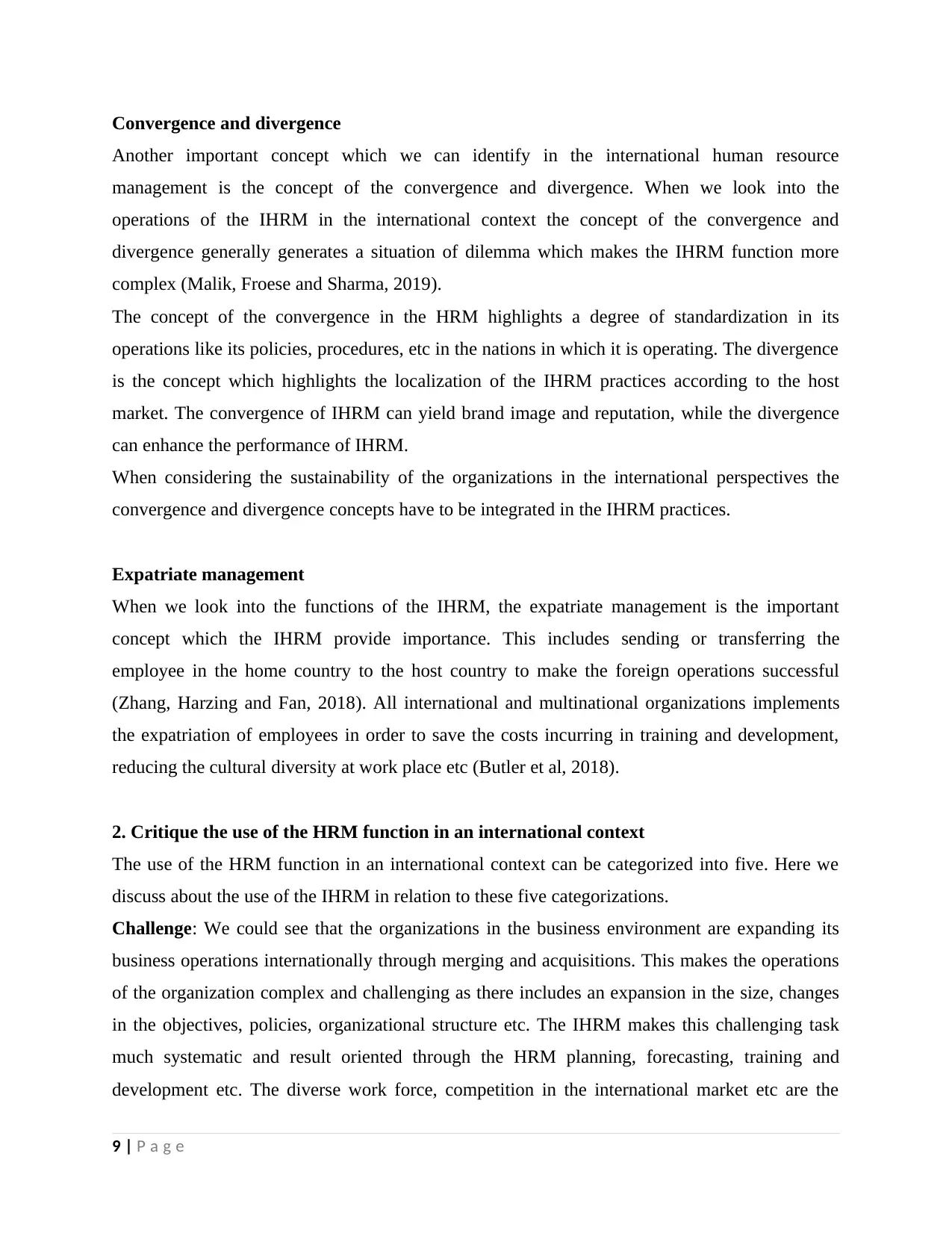
Convergence and divergence
Another important concept which we can identify in the international human resource
management is the concept of the convergence and divergence. When we look into the
operations of the IHRM in the international context the concept of the convergence and
divergence generally generates a situation of dilemma which makes the IHRM function more
complex (Malik, Froese and Sharma, 2019).
The concept of the convergence in the HRM highlights a degree of standardization in its
operations like its policies, procedures, etc in the nations in which it is operating. The divergence
is the concept which highlights the localization of the IHRM practices according to the host
market. The convergence of IHRM can yield brand image and reputation, while the divergence
can enhance the performance of IHRM.
When considering the sustainability of the organizations in the international perspectives the
convergence and divergence concepts have to be integrated in the IHRM practices.
Expatriate management
When we look into the functions of the IHRM, the expatriate management is the important
concept which the IHRM provide importance. This includes sending or transferring the
employee in the home country to the host country to make the foreign operations successful
(Zhang, Harzing and Fan, 2018). All international and multinational organizations implements
the expatriation of employees in order to save the costs incurring in training and development,
reducing the cultural diversity at work place etc (Butler et al, 2018).
2. Critique the use of the HRM function in an international context
The use of the HRM function in an international context can be categorized into five. Here we
discuss about the use of the IHRM in relation to these five categorizations.
Challenge: We could see that the organizations in the business environment are expanding its
business operations internationally through merging and acquisitions. This makes the operations
of the organization complex and challenging as there includes an expansion in the size, changes
in the objectives, policies, organizational structure etc. The IHRM makes this challenging task
much systematic and result oriented through the HRM planning, forecasting, training and
development etc. The diverse work force, competition in the international market etc are the
9 | P a g e
Another important concept which we can identify in the international human resource
management is the concept of the convergence and divergence. When we look into the
operations of the IHRM in the international context the concept of the convergence and
divergence generally generates a situation of dilemma which makes the IHRM function more
complex (Malik, Froese and Sharma, 2019).
The concept of the convergence in the HRM highlights a degree of standardization in its
operations like its policies, procedures, etc in the nations in which it is operating. The divergence
is the concept which highlights the localization of the IHRM practices according to the host
market. The convergence of IHRM can yield brand image and reputation, while the divergence
can enhance the performance of IHRM.
When considering the sustainability of the organizations in the international perspectives the
convergence and divergence concepts have to be integrated in the IHRM practices.
Expatriate management
When we look into the functions of the IHRM, the expatriate management is the important
concept which the IHRM provide importance. This includes sending or transferring the
employee in the home country to the host country to make the foreign operations successful
(Zhang, Harzing and Fan, 2018). All international and multinational organizations implements
the expatriation of employees in order to save the costs incurring in training and development,
reducing the cultural diversity at work place etc (Butler et al, 2018).
2. Critique the use of the HRM function in an international context
The use of the HRM function in an international context can be categorized into five. Here we
discuss about the use of the IHRM in relation to these five categorizations.
Challenge: We could see that the organizations in the business environment are expanding its
business operations internationally through merging and acquisitions. This makes the operations
of the organization complex and challenging as there includes an expansion in the size, changes
in the objectives, policies, organizational structure etc. The IHRM makes this challenging task
much systematic and result oriented through the HRM planning, forecasting, training and
development etc. The diverse work force, competition in the international market etc are the
9 | P a g e
⊘ This is a preview!⊘
Do you want full access?
Subscribe today to unlock all pages.

Trusted by 1+ million students worldwide
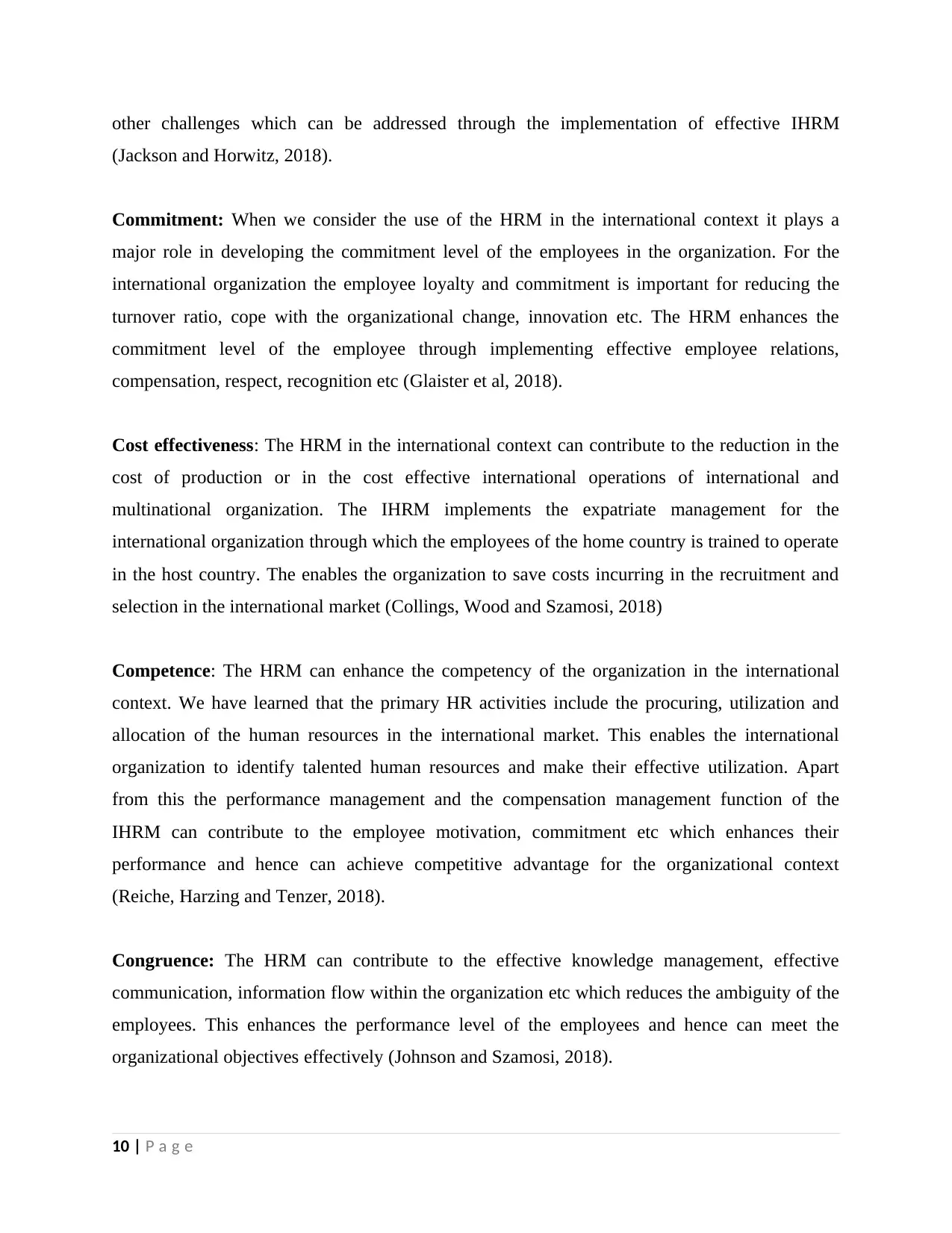
other challenges which can be addressed through the implementation of effective IHRM
(Jackson and Horwitz, 2018).
Commitment: When we consider the use of the HRM in the international context it plays a
major role in developing the commitment level of the employees in the organization. For the
international organization the employee loyalty and commitment is important for reducing the
turnover ratio, cope with the organizational change, innovation etc. The HRM enhances the
commitment level of the employee through implementing effective employee relations,
compensation, respect, recognition etc (Glaister et al, 2018).
Cost effectiveness: The HRM in the international context can contribute to the reduction in the
cost of production or in the cost effective international operations of international and
multinational organization. The IHRM implements the expatriate management for the
international organization through which the employees of the home country is trained to operate
in the host country. The enables the organization to save costs incurring in the recruitment and
selection in the international market (Collings, Wood and Szamosi, 2018)
Competence: The HRM can enhance the competency of the organization in the international
context. We have learned that the primary HR activities include the procuring, utilization and
allocation of the human resources in the international market. This enables the international
organization to identify talented human resources and make their effective utilization. Apart
from this the performance management and the compensation management function of the
IHRM can contribute to the employee motivation, commitment etc which enhances their
performance and hence can achieve competitive advantage for the organizational context
(Reiche, Harzing and Tenzer, 2018).
Congruence: The HRM can contribute to the effective knowledge management, effective
communication, information flow within the organization etc which reduces the ambiguity of the
employees. This enhances the performance level of the employees and hence can meet the
organizational objectives effectively (Johnson and Szamosi, 2018).
10 | P a g e
(Jackson and Horwitz, 2018).
Commitment: When we consider the use of the HRM in the international context it plays a
major role in developing the commitment level of the employees in the organization. For the
international organization the employee loyalty and commitment is important for reducing the
turnover ratio, cope with the organizational change, innovation etc. The HRM enhances the
commitment level of the employee through implementing effective employee relations,
compensation, respect, recognition etc (Glaister et al, 2018).
Cost effectiveness: The HRM in the international context can contribute to the reduction in the
cost of production or in the cost effective international operations of international and
multinational organization. The IHRM implements the expatriate management for the
international organization through which the employees of the home country is trained to operate
in the host country. The enables the organization to save costs incurring in the recruitment and
selection in the international market (Collings, Wood and Szamosi, 2018)
Competence: The HRM can enhance the competency of the organization in the international
context. We have learned that the primary HR activities include the procuring, utilization and
allocation of the human resources in the international market. This enables the international
organization to identify talented human resources and make their effective utilization. Apart
from this the performance management and the compensation management function of the
IHRM can contribute to the employee motivation, commitment etc which enhances their
performance and hence can achieve competitive advantage for the organizational context
(Reiche, Harzing and Tenzer, 2018).
Congruence: The HRM can contribute to the effective knowledge management, effective
communication, information flow within the organization etc which reduces the ambiguity of the
employees. This enhances the performance level of the employees and hence can meet the
organizational objectives effectively (Johnson and Szamosi, 2018).
10 | P a g e
Paraphrase This Document
Need a fresh take? Get an instant paraphrase of this document with our AI Paraphraser
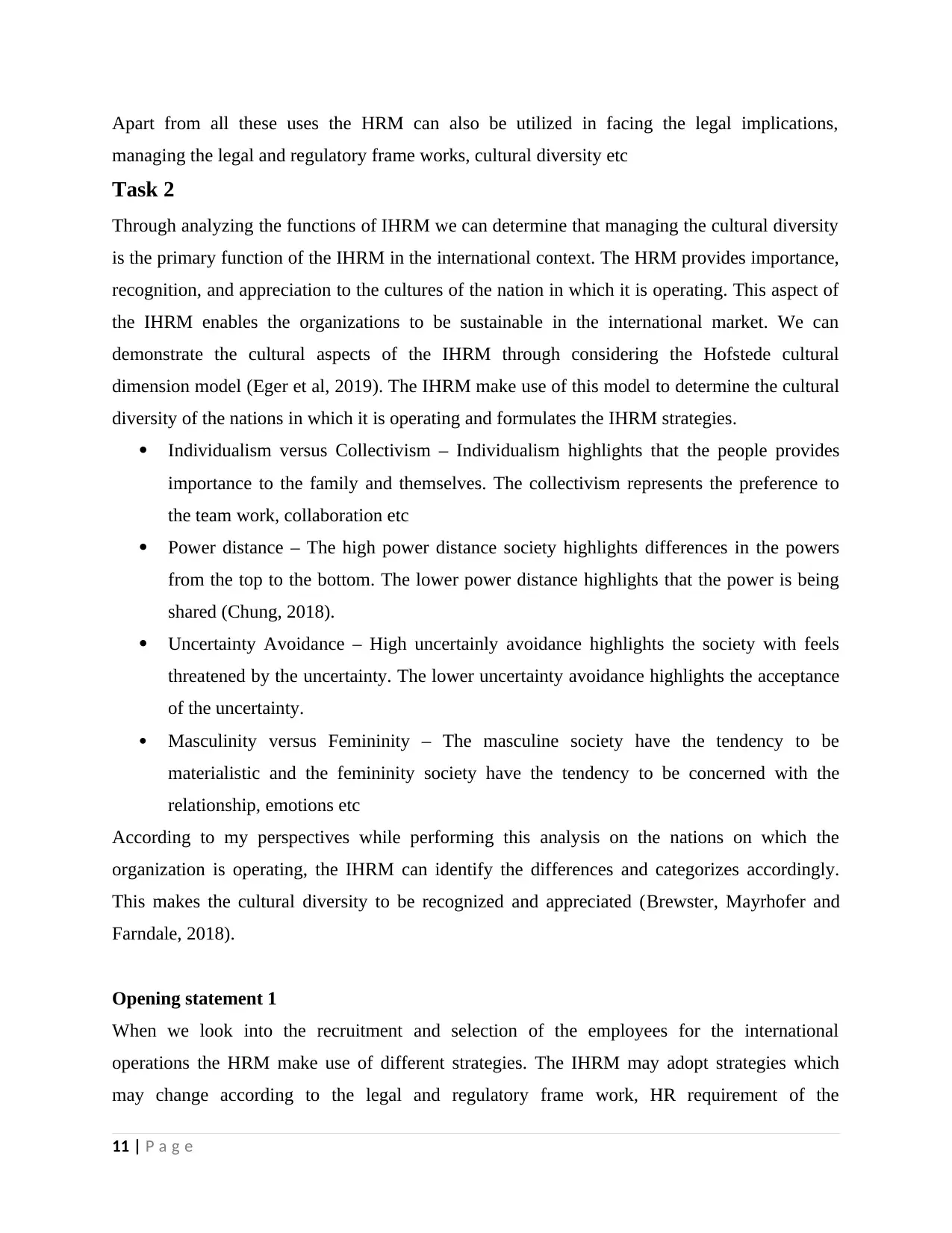
Apart from all these uses the HRM can also be utilized in facing the legal implications,
managing the legal and regulatory frame works, cultural diversity etc
Task 2
Through analyzing the functions of IHRM we can determine that managing the cultural diversity
is the primary function of the IHRM in the international context. The HRM provides importance,
recognition, and appreciation to the cultures of the nation in which it is operating. This aspect of
the IHRM enables the organizations to be sustainable in the international market. We can
demonstrate the cultural aspects of the IHRM through considering the Hofstede cultural
dimension model (Eger et al, 2019). The IHRM make use of this model to determine the cultural
diversity of the nations in which it is operating and formulates the IHRM strategies.
Individualism versus Collectivism – Individualism highlights that the people provides
importance to the family and themselves. The collectivism represents the preference to
the team work, collaboration etc
Power distance – The high power distance society highlights differences in the powers
from the top to the bottom. The lower power distance highlights that the power is being
shared (Chung, 2018).
Uncertainty Avoidance – High uncertainly avoidance highlights the society with feels
threatened by the uncertainty. The lower uncertainty avoidance highlights the acceptance
of the uncertainty.
Masculinity versus Femininity – The masculine society have the tendency to be
materialistic and the femininity society have the tendency to be concerned with the
relationship, emotions etc
According to my perspectives while performing this analysis on the nations on which the
organization is operating, the IHRM can identify the differences and categorizes accordingly.
This makes the cultural diversity to be recognized and appreciated (Brewster, Mayrhofer and
Farndale, 2018).
Opening statement 1
When we look into the recruitment and selection of the employees for the international
operations the HRM make use of different strategies. The IHRM may adopt strategies which
may change according to the legal and regulatory frame work, HR requirement of the
11 | P a g e
managing the legal and regulatory frame works, cultural diversity etc
Task 2
Through analyzing the functions of IHRM we can determine that managing the cultural diversity
is the primary function of the IHRM in the international context. The HRM provides importance,
recognition, and appreciation to the cultures of the nation in which it is operating. This aspect of
the IHRM enables the organizations to be sustainable in the international market. We can
demonstrate the cultural aspects of the IHRM through considering the Hofstede cultural
dimension model (Eger et al, 2019). The IHRM make use of this model to determine the cultural
diversity of the nations in which it is operating and formulates the IHRM strategies.
Individualism versus Collectivism – Individualism highlights that the people provides
importance to the family and themselves. The collectivism represents the preference to
the team work, collaboration etc
Power distance – The high power distance society highlights differences in the powers
from the top to the bottom. The lower power distance highlights that the power is being
shared (Chung, 2018).
Uncertainty Avoidance – High uncertainly avoidance highlights the society with feels
threatened by the uncertainty. The lower uncertainty avoidance highlights the acceptance
of the uncertainty.
Masculinity versus Femininity – The masculine society have the tendency to be
materialistic and the femininity society have the tendency to be concerned with the
relationship, emotions etc
According to my perspectives while performing this analysis on the nations on which the
organization is operating, the IHRM can identify the differences and categorizes accordingly.
This makes the cultural diversity to be recognized and appreciated (Brewster, Mayrhofer and
Farndale, 2018).
Opening statement 1
When we look into the recruitment and selection of the employees for the international
operations the HRM make use of different strategies. The IHRM may adopt strategies which
may change according to the legal and regulatory frame work, HR requirement of the
11 | P a g e
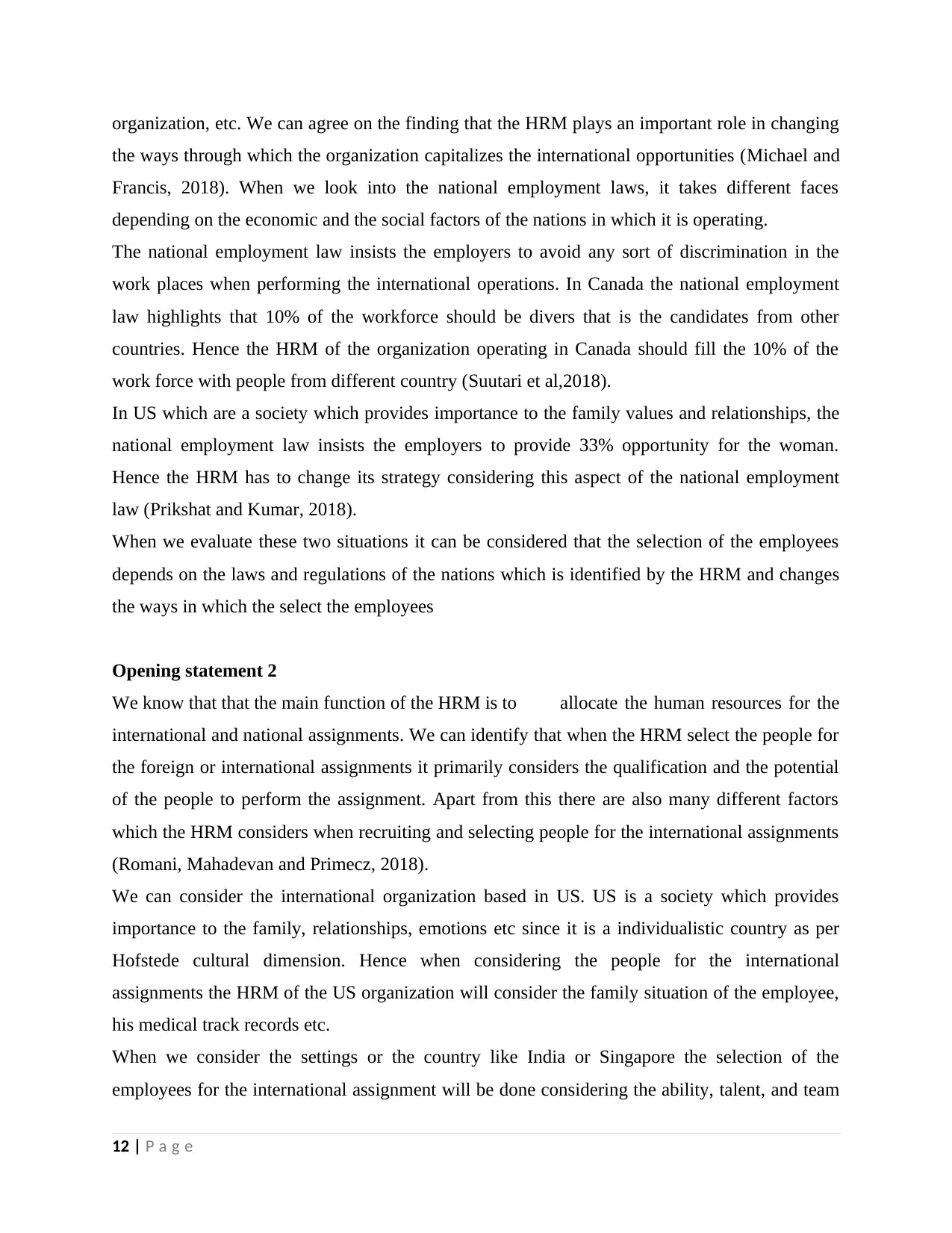
organization, etc. We can agree on the finding that the HRM plays an important role in changing
the ways through which the organization capitalizes the international opportunities (Michael and
Francis, 2018). When we look into the national employment laws, it takes different faces
depending on the economic and the social factors of the nations in which it is operating.
The national employment law insists the employers to avoid any sort of discrimination in the
work places when performing the international operations. In Canada the national employment
law highlights that 10% of the workforce should be divers that is the candidates from other
countries. Hence the HRM of the organization operating in Canada should fill the 10% of the
work force with people from different country (Suutari et al,2018).
In US which are a society which provides importance to the family values and relationships, the
national employment law insists the employers to provide 33% opportunity for the woman.
Hence the HRM has to change its strategy considering this aspect of the national employment
law (Prikshat and Kumar, 2018).
When we evaluate these two situations it can be considered that the selection of the employees
depends on the laws and regulations of the nations which is identified by the HRM and changes
the ways in which the select the employees
Opening statement 2
We know that that the main function of the HRM is to allocate the human resources for the
international and national assignments. We can identify that when the HRM select the people for
the foreign or international assignments it primarily considers the qualification and the potential
of the people to perform the assignment. Apart from this there are also many different factors
which the HRM considers when recruiting and selecting people for the international assignments
(Romani, Mahadevan and Primecz, 2018).
We can consider the international organization based in US. US is a society which provides
importance to the family, relationships, emotions etc since it is a individualistic country as per
Hofstede cultural dimension. Hence when considering the people for the international
assignments the HRM of the US organization will consider the family situation of the employee,
his medical track records etc.
When we consider the settings or the country like India or Singapore the selection of the
employees for the international assignment will be done considering the ability, talent, and team
12 | P a g e
the ways through which the organization capitalizes the international opportunities (Michael and
Francis, 2018). When we look into the national employment laws, it takes different faces
depending on the economic and the social factors of the nations in which it is operating.
The national employment law insists the employers to avoid any sort of discrimination in the
work places when performing the international operations. In Canada the national employment
law highlights that 10% of the workforce should be divers that is the candidates from other
countries. Hence the HRM of the organization operating in Canada should fill the 10% of the
work force with people from different country (Suutari et al,2018).
In US which are a society which provides importance to the family values and relationships, the
national employment law insists the employers to provide 33% opportunity for the woman.
Hence the HRM has to change its strategy considering this aspect of the national employment
law (Prikshat and Kumar, 2018).
When we evaluate these two situations it can be considered that the selection of the employees
depends on the laws and regulations of the nations which is identified by the HRM and changes
the ways in which the select the employees
Opening statement 2
We know that that the main function of the HRM is to allocate the human resources for the
international and national assignments. We can identify that when the HRM select the people for
the foreign or international assignments it primarily considers the qualification and the potential
of the people to perform the assignment. Apart from this there are also many different factors
which the HRM considers when recruiting and selecting people for the international assignments
(Romani, Mahadevan and Primecz, 2018).
We can consider the international organization based in US. US is a society which provides
importance to the family, relationships, emotions etc since it is a individualistic country as per
Hofstede cultural dimension. Hence when considering the people for the international
assignments the HRM of the US organization will consider the family situation of the employee,
his medical track records etc.
When we consider the settings or the country like India or Singapore the selection of the
employees for the international assignment will be done considering the ability, talent, and team
12 | P a g e
⊘ This is a preview!⊘
Do you want full access?
Subscribe today to unlock all pages.

Trusted by 1+ million students worldwide
1 out of 19
Related Documents
Your All-in-One AI-Powered Toolkit for Academic Success.
+13062052269
info@desklib.com
Available 24*7 on WhatsApp / Email
![[object Object]](/_next/static/media/star-bottom.7253800d.svg)
Unlock your academic potential
Copyright © 2020–2025 A2Z Services. All Rights Reserved. Developed and managed by ZUCOL.





